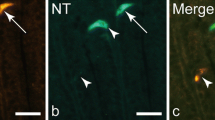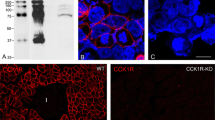Summary
Numerous endocrine cells can be observed in the gut of the lizard Podarcis hispanica after application of the Grimelius silver nitrate technique. The argyrophilic endocrine cells are usually tall and thin in the small intestine but short, basal, and round in the large intestine. Eleven types of immunoreactive endocrine cells have been identified by immunocytochemical methods. Numerous serotonin-, caerulein/gastrin/cholecystokinin octapeptide-and peptide tyrosine-tyrosine-immunoreactive cells; a moderate number of pancreatic polypeptide-, neurotensin-, somatostatin-, glucagon-like peptide-1-and glucagon-immunoreactive cells, and few cholecystokinin N-terminal-and bombesin-immunoreactive cells were found in the epithelium of the small intestine. Coexistence of glucagon with GLP-1 or PP/PYY has been observed in some cells. In the large intestine a small number of serotonin-, peptide tyrosine-tyrosine-, pancreatic polypeptide-, neurotensin-, somatostatin-and glucagon-like peptide-1-immunoreactive cells were detected. Vasoactive intestinal peptide immunoreactivity was found in nerve fibers of the muscular layer. Substance P-immunoreactive nerve fibers were detected in lamina propria, submucosa and muscular layer. Chromogranin A-immunoreactive cells were observed throughout the intestine, although in lower numbers than argyrophilic cells.
Similar content being viewed by others
References
Ali-Rachedi A, Varndell IM, Adrian TE, Gapp DA, Van Noorden S, Bloom SR, Polak JM (1984) Peptide YY (PYY) immunoreactivity is co-stored with glucagon-related immunoreactants in endocrine cells of the gut and pancreas. Histochemistry 80:487–491
Arena PC, Richardson KC, Yamada J (1990) An immunohistochemical study of endocrine cells of the alimentary tract of the King's shink (Ergenia kingii). J Anat 170:73–85
Buchan AMJ, Lance V, Polak JM (1983) Regulatory peptides in the gastrointestinal tract of Alligator mississipiensis. An immunocytochemical study. Cell Tissue Res 231:439–449
Buffa R, Solovieva I, Fiocca R, Giorgino S, Rindi G, Solcia E, Mochizuchi T, Yanaihara C, Yanaihara N (1982) Localization of bombesin and GRP (gastrin releasing peptide) sequences in gut nerves or endocrine cells. Histochemistry 76:457–467
Cetin Y (1990) Secretin-cells of the mammalian intestine contain serotonin. Histochemistry 93:601–606
Cetin Y, Müller-Köppel L, Aunis D, Bader M-F, Grube D (1989) Chromogranin A (Cg A) in the gastro-entero-pancreatic (GEP) endocrine system II. Cg A in mammalian entero-endocrine cells. Histochemistry 92:265–275
Conlon JM (1988) Proglucagon-derived peptides: nomenclature, biosynthetic relationships and physiological roles. Diabetologia 31:563–566
Dimaline R, Rawdon BB, Brandes S, Andrew A, Loveridge JP (1982) Biologically active gastrin/CCK-related peptides in the stomach of a reptile, Crocodylus niloticus, identified and characterized by immunochemical methods. Peptides 3:977–984
El-Salhy M, Grimelius L (1981) The endocrine cells of the gastrointestinal mucosa of a squamate reptile, the grass lizard (Mabuya quinquetaeniata). A histological and immunohistochemical study. Biomed Res 2:639–658
El-Salhy M, Grimelius L, Lundberg JM, Tatemoto K, Terenius L (1982) Immunocytochemical evidence for the occurrence of PYY, a newly isolated gut polypeptide, in endocrine cells in the gut of amphibians and reptiles. Biomed Res 3:303–306
Falkmer S, Elde RP, Hellerström C, Petersson B (1978) Phylogenetic aspects of somatostatin in the gastroenteropancreatic (GEP) endocrine system. Metabolism 27 [Suppl 1]:1193–1196
Falkmer S, El-Salhy M, Titlbach M (1984) Evolution of the neuroendocrine system in vertebrates. A review with particular reference to the phylogeny and postnatal maturation of the islet parenchyma. In: Falkmer S, Håkanson R, Sundler F (eds) Evolution and tumour pathology of the neuroendocrine system. Elsevier, Amsterdam New York Oxford, pp 60–87
Gapp DA, Polak JM (1990) Localization of insulin to gastroenteropancreatic cells in the turtle gastrointestinal tract. Gen Comp Endocrinol 78:48–55
Gapp DA, Kenny MP, Polak JM (1985) The gastro-entero-pancreatic system of the turtle, Chrysemys picta. Peptides 6 [Suppl 3]:347–352
Grimelius L (1968) A silver nitrate strain for A2 cells in human pancreatic islets. Acta Soc Upsal 73:243–270
Hsu S-M, raine L, Fanger H (1981) Use of avidin-biotin-peroxidase complex (ABC) in immunoperoxidase techniques: a comparison between ABC and unlabeled antibody (PAP) procedures. J Histochem Cytochem 29:577–580
Kanamori Y, Nakazawa S, Kitoh J, Hoshino M (1989) The distribution of endocrine cells in the mucosa of the gastrointestinal tract of the house musk shrew, Suncus murinus (Insectivora). Cell Tissue Res 258:365–371
Larsson L-I (1988) Immunocytochemistry: theory and practice. CRC Press, Boca Raton, Fla
Larsson L-I, Rehfeld JF (1977) Evidence for a common evolutionary origin of gastrin and cholecystokinin. Nature 269:335–338
Masini MA (1986) Immunohistochemical localization of gut peptides in the small intestine of snakes. Basic Appl Histochem 30:317–324
Osamura RY, Watanabe K, Nakai Y, Imura H (1980) Adrenocorticotropic hormone cells and immunoreactive β-endorphin cells in the human pituitary glands. Normal and pathological conditions studied by the peroxidase-labeled antibody method. Am J Pathol 99:105–124
Owman C, Håkanson R, Sundler F (1973) Occurrence and function of amines in endocrine cells producing polypeptide hormones. Federation Proc 32:1785–1791
Perez-Tomas R, Ballesta J, Pastor LM, Hernandez F (1989a) Ultrastructural study of the endocrine cells of the gut of Testudo graeca (Chelonia). Anat Embryol 180:103–108
Perez-Tomas R, Ballesta J, Pastor LM, Madrid JF, Polak JM (1989b) Comparative immunohistochemical study of the gastroenteropancreatic (GEP) endocrine system of three reptiles. Gen Comp Endocrinol 76:171–191
Polak JM, Bloom SR (1989) Introduction. In: Polak JM (ed) Regulatory peptides. Birkhäuser, Basel Boston Berlin, pp 1–10
Reinecke M, Almassan K, Carraway R, Helmstaedter V, Forssman WG (1980) Distribution patterns of neurotensin-like immunoreactive cells in the gastro-intestinal tract of higher vertebrates. Cell Tissue Res 205:383–395
Reinecke M, Schlüter P, Yanaihara N, Forssmann WG (1981) VIP immunoreactivity in enteric nerves and endocrine cells of the vertebrate gut. Peptides 2 [Suppl 2]:149–156
Rindi G, Buffa R, Sessa F, Tortora O, Solcia E (1986) Chromogranin A, B and C immunoreactivities of mammalian endocrine cells. Distribution, distinction from costored hormones/prohormones and relationship with the argyrophil component of secretory granules. Histochemistry 85:19–28
Seino Y, Porte D, Smith PH (1979) Immunohistochemical localization of somatostatin-containing cells in the intestinal tract: a comparative study. Gen Comp Endocrinol 38:229–233
Solcia E, Buffa R, Capella C, Fiocca R, Fontana P, Crivelli O (1979) Immunohistochemical characterization of gastroenteropancreatic endocrine cells and related multihormonal cells. In: Miyoshi A (ed) Gut peptides. Secretion, function and clinical aspects. Kodansha, Tokyo, pp 303–309
Solcia E, Polak JM, Larsson L-I, Buchan AMJ, Capella C (1981) Update on Lausanne classification of endocrine cells. In: Bloom SR, Polak JM (eds) Gut Hormones, 2nd edn. Churchill Livingstone, Edinburgh London Melbourne New York, pp 96–100
Solcia E, Fiocca R, Capella C, Usellini L, Sessa F, Rindi G, Schwartz TW, Yanaihara N (1985) Glucagon-and PP-related peptides of intestinal L cells and pancreatic/gastric A or PP cells. Possible interrelationships of peptides and cells during evolution, fetal development and tumor growth. Peptides 6 [Suppl 3]:223–229
Solcia E, Usellini L, Buffa R, Rindi G, Villani L, Aguzzi A, Silini E (1989) Endocrine cells producing regulatory peptides. In: Polak JM (ed) Regulatory peptides. Birkhäuser, Basel Boston Berlin, pp 220–246
Sternberger LA (1979) Immunocytochemistry, 2nd edn. Wiley, New York
Tatemoto K, Mutt V (1980) Isolation of two novel candidate hormones using a chemical method for finding naturally occurring polypeptides. Nature 285:417–418
Thorndyke MC (1986) Immunocytochemistry and evolutionary studies with particular reference to peptides. In: Polak JM, Van Noorden S (eds) Immunocytochemistry. Modern methods and applications, 2nd edn. Wright, Bristol, pp 308–327
Vaillant C, Taylor IL (1981) Demonstration of carboxyl-terminal PP-like peptides in endocrine cells and nerves. Peptides 2 [Suppl 2]:31–35
Varndell IM, Bishop AE, Sikri KL, Uttenthal LO, Bloom SR, Polak JM (1985) Localization of glucagon-like peptide (GLP) immunoreactants in human gut and pancreas using light and electron microscopic immunocytochemistry. J Histochem Cytochem 33:1080–1086
Yamada J, Campos VJM, Kitamura N, Pacheco AC, Yamashita T, Yanaihara N (1987) An immunohistochemical study of the endocrine cells in the gastrointestinal mucosa of the Caiman latirostris. Arch Histol Jap 50:229–241
Author information
Authors and Affiliations
Rights and permissions
About this article
Cite this article
Burrell, M.A., Villaro, A.C., Rindi, G. et al. An histological and immunocytochemical study of the neuroendocrine cells in the intestine of Podarcis hispanica Steindachner, 1870 (Lacertidae). Cell Tissue Res 263, 549–556 (1991). https://doi.org/10.1007/BF00327288
Accepted:
Issue Date:
DOI: https://doi.org/10.1007/BF00327288




